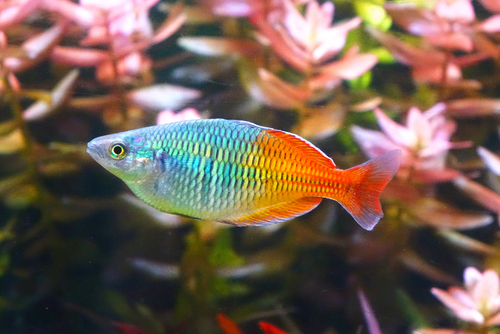Just like there are many colors in the rainbow, there are many types of rainbow fish. Overall, this type of fish is a beloved pet because of how they light up any aquarium. In terms of tank mates, they are friendly fish who don’t mind sharing an adequately sized tank with others.
The best rainbow fish tank mates include fish that are also calm and pleasant, and don’t mind sharing space with multiple rainbow fish. It’s also beneficial to pair the rainbow fish with other fish who enjoy swimming around, as their propensity to dart around an aquarium may scare a shy fish.
Since the rainbow fish has a quieter, friendly nature and likes to swim, they shouldn’t live with aggressive fish.
Contents
Rainbow Fish Tank Mates – What You Need To Know
The good news is that getting to understand the rainbow fish and what it likes isn’t difficult, even if you’re not a seasoned fish parent. There are some things that are a priority to know so you can start building the right habitat for your rainbow fish and their potential friends.
Temperament
The rainbow fish is a very kind fish, which makes it easier to set up an aquarium with a few kinds of fish. There are a lot of options in terms of companions that will live peacefully with a rainbow fish, giving you the option to create a one-of-a-kind aquarium setup.
What should be noted is that they won’t fare well with fish that like to try and overpower others or dominate the aquarium.
Size
Rainbow fish can be found in a varied size range since there are numerous kinds of rainbow fish. You can find this species anywhere from 2 inches to 8 inches when full-grown.
Competition
Rainbow fish aren’t fans of competitive atmospheres, so it’s important that you don’t inadvertently set one up with the wrong tank mates. They like being housed with other rainbow fish, and typically hang out in the top and middle of the water.
Parameters ; Tank Setup
The rainbow fish is a nicely adaptable fish that is able to handle slight changes in their water should they accidentally occur. One thing of note is different types of rainbow fish like different water types, so you should know what you’re bringing home.
Overall, they prefer water between 74-80 °F, fairly hard water, and pH between 6.5 and 8.0.
12 Best Rainbow Fish Tank Mates
Other similar posts you don’t want to miss:
- Best Mollies Tank Mates
- African Cichlids Tank Mates
- Jack Dempsey Tank Mates
- African Clawed Frog Tank Mates
1. Mollies
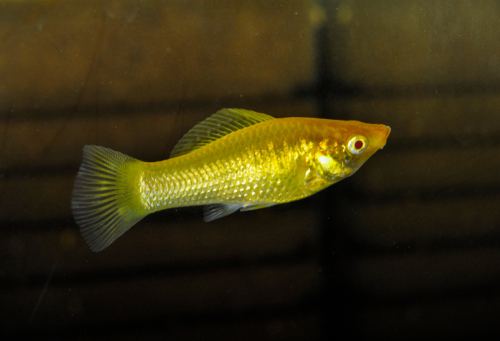
- Scientific Name: Poecilia sphenops
- Adult Size: 5-6 inches
- Compatible with: Guppies, swordtail, tetras
- Water Temperature: 75-80 °F
- Minimum tank size: 10 gallon
- Care Level: Easy
- Origin: Central America and United States
Mollies are a beloved fish for many different kinds of fish and fish parents alike. Your rainbow fish will enjoy how kind this fish is. They are a very friendly fish and get along well with rainbow fish, as neither will try to overpower the other.
Pros
- Both fish have similar temperaments
- Both fish like the same water conditions
Cons
- Mollies need to live in schools with multiple mollies
2. Tetras
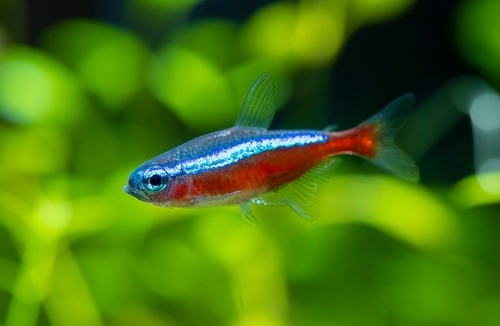
- Scientific Name: Tetragonopterus
- Adult Size: 2 inches
- Compatible with: Rasboras, guppies, loaches
- Water Temperature: 70-80 °F
- Minimum tank size: 10 gallons
- Care Level: Easy
- Origin: South and Central America, Africa
Tetras come in many shapes, sizes, colors, and temperaments, but are beloved fish nonetheless. Your rainbow fish will also enjoy this schooling fish as they don’t take up a lot of space but will enjoy interactions.
Pros
- Tetras can adapt well to a rainbow fish’s preferred tank requirements
Cons
- Tetras don’t like overly warm water, so you’ll have to stay mindful of temperature
3. Rasboras
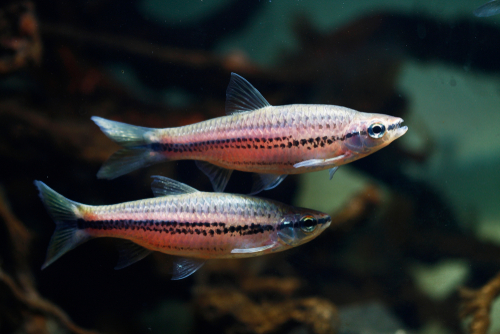
- Scientific Name: Rasbora cephalotaenia
- Adult Size: 2 inches
- Compatible with: Platies, guppies, danios
- Water Temperature: 75-80 °F
- Minimum tank size: 20 gallons
- Care Level: Moderate
- Origin: South and Southeast Asia
You’ll adore just how stunning the rasbora is and all the glisten they add to an aquarium. Once your rasboras and rainbow fish get to know each other, both fish will benefit from the other’s personality.
Pros
- Rasboras also like to live in schools like rainbow fish
Cons
- Rasboras can be shy, so they might be intimidated by rainbow fish at first
- Rasboras need lots of decorations and potential hiding spots
4. Platies
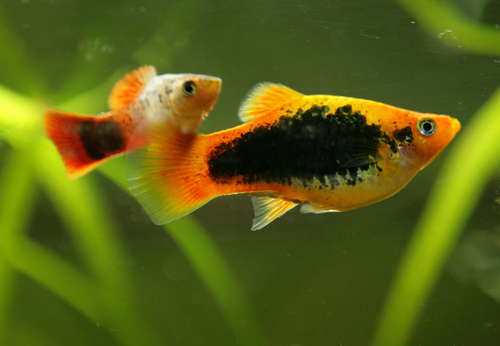
- Scientific Name: Xiphophorus maculatus
- Adult Size: 2-3 inches
- Compatible with: Cory catfish, bettas, mollies
- Water Temperature: 70-82 °F
- Minimum tank size: 20 gallons
- Care Level: Easy
- Origin: Central America
Platies make for lovely companions to rainbow fish. Both are active and lively and so they’ll have a great time together. Even though they’ll like each other, platies don’t want to be pestered all day.
Pros
- Both fish like the same kind of tank setup
- Platies are very easy to feed
Cons
- Platies need to have somewhere they can escape to when they’re tired, such as caves and toys
5. Guppies
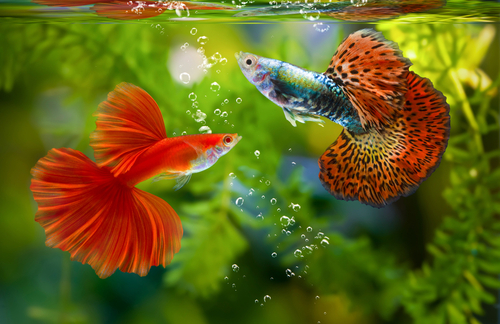
- Scientific Name: Poecilia reticulata
- Adult Size: 1-2 inches
- Compatible with: Mollies, livebearers, cory catfish
- Water Temperature: 72-82 °F
- Minimum tank size: 5 gallons
- Care Level: Easy
- Origin: South America
Everyone loves guppies, and that includes rainbow fish. Since both fish like to live in schools, you’re going to want a decent sized tank. This will make sure they can swim around and play while also being able to relax on their own when needed.
Pros
- Guppies are very easy for other fish to get along with
- Guppies are also simple fish to care for
Cons
- As mentioned, both types of fish like to school, so you can’t get along with a small aquarium
6. Gouramis
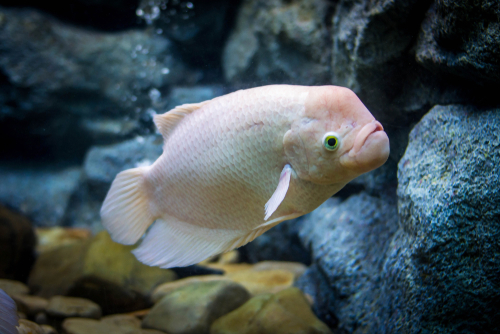
- Scientific Name: Osphronemidae
- Adult Size: 3-4 inches
- Compatible with: Kuhli loach, swordtails, corydoras
- Water Temperature: 75-80 °F
- Minimum tank size: 10 gallons
- Care Level: Easy to moderate
- Origin: Eastern and Southern Asia
If you’re thinking of pairing up some gouramis with your rainbow fish, you’ll have the most success with a dwarf gourami. Your gouramis might not interact with your rainbow fish that much, but so long as your rainbow fish has others to swim around with, this won’t be a big deal.
Pros
- Dwarf gouramis are more peaceful than some other types of gouramis
Cons
- Not all gouramis will get along well with a rainbow fish
7. Plecos
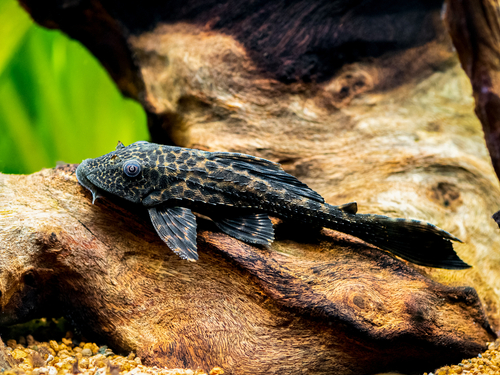
- Scientific Name: Hypostomus plecostomus
- Adult Size: 15 inches
- Compatible with: Bettas, guppies, platies
- Water Temperature: 74-80 °F
- Minimum tank size: 75-80 gallons
- Care Level: Easy
- Origin: South America
While it might seem like plecos are very large and might try to intimidate a rainbow fish, they definitely won’t be a nuisance. They like having a lot of space to swim around and will otherwise mind their own business. They tend to prefer the bottom of the tank as well.
Pros
- Plecos help eat up algae and other debris
- Plecos won’t hassle or bother your rainbow fish
Cons
- You need a large sized aquarium to make sure your pleco is comfortable
8. Barbs
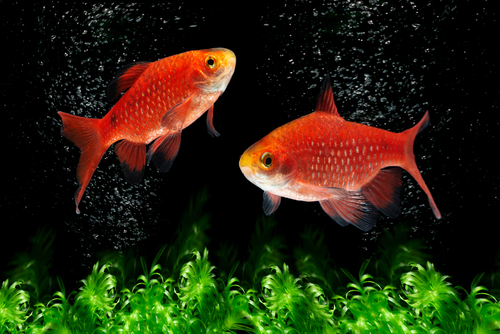
- Scientific Name: Barbus
- Adult Size: 2-4 inches
- Compatible with: Neon tetra, clown loach, red tail shark
- Water Temperature: 75-80 °F
- Minimum tank size: 20-55 gallon
- Care Level: Easy
- Origin: Africa, Europe, Asia
Various types of barbs are known to be very active and tend to like swimming around in schools around the middle of the tank. If you want the perfect barb for a rainbow fish to be friendly with, a tiger barb tends to be the top choice.
Pros
- Tiger barbs are energetic, schooling fish, just like rainbow fish
Cons
- Some types of barbs will nip on fins
9. Swordtail fish
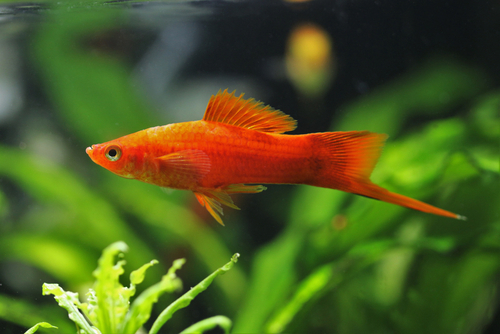
- Scientific Name: Xiphophorus hellerii
- Adult Size: 5-6 inches
- Compatible with: Angelfish, dwarf gourami, barbs
- Water Temperature: 72-79 °F
- Minimum tank size: 15 gallon
- Care Level: Easy
- Origin: North and Central America
Rainbow fish and swordtail fish can appreciate each other’s company, as both types of fish are good at sharing space and are fairly calm in the water. The swordtail prefers to bounce between the middle and the top of an aquarium, while the rainbow fish likes the top.
Pros
- Both fish have similar personalities and preferences
- Both fish are also easy to take care of
Cons
- Male swordtail fish can be aggressive, so you’ll want to avoid having multiple in one tank
10. Danios
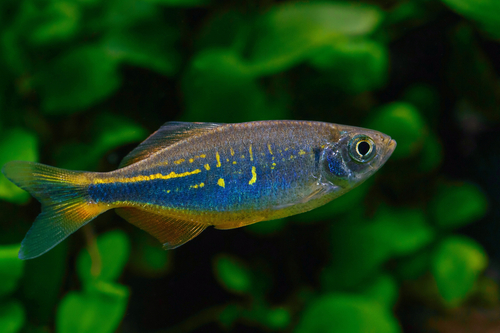
- Scientific Name: Danio
- Adult Size: 2-5 inches
- Compatible with: Barbs, goldfish, guppies
- Water Temperature: 70-78 °F
- Minimum tank size: 10 gallon
- Care Level: Easy
- Origin: South and Southeast Asia
Many kinds of danios exist, and a zebra danio or pearl danio would be suited best to life with a rainbow fish. These small little danios like living with other danios, and when they do, they’ll swim and play with other fish happily as they can rely on their security net if needed.
Pros
- Zebra and pearl danios are nimble, and will love swimming around with rainbow fish
Cons
- Danios need to be in schools to feel secure; consider having at least four
11. Loaches
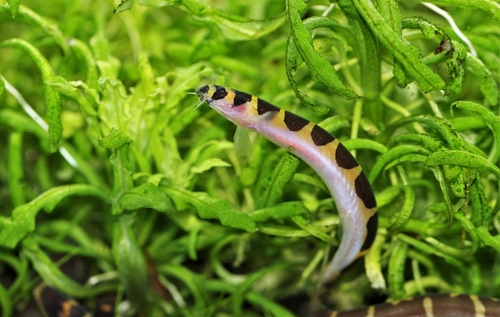
- Scientific Name: Cobitidae
- Adult Size: 4-6 inches
- Compatible with: Gourami, severums, angelfish
- Water Temperature: 59-77 °F
- Minimum tank size: 55 gallons
- Care Level: Easy
- Origin: Central and South Asia
Loaches are bottom dwelling fish and rainbow fish like swimming around the top, so these fish will coexist more than they’ll interact. If you’d like to introduce a loach to a rainbow fish’s tank, either a clown loach or botia loach is recommended.
Pros
- Loaches benefit any tank for eating up algae and scraps
- Loaches and rainbow fish live in the same kinds of water parameters
Cons
- Loaches may not get enough food because of how rainbow fish like to eat; this will have to be monitored
12. Angelfish
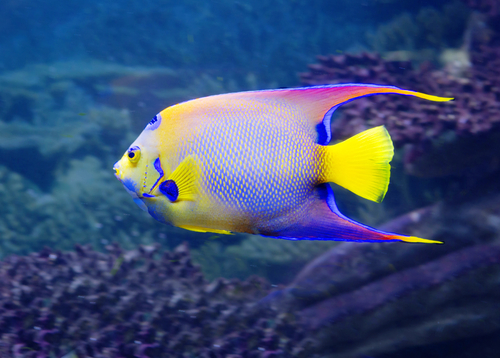
- Scientific Name: Pterophyllum
- Adult Size: 6 inches
- Compatible with: Zebra loach, corydoras, platies
- Water Temperature: 82°F and above
- Minimum tank size: 20 gallons
- Care Level: Easy
- Origin: South America
Angelfish are cichlids, but don’t act in the same aggressive manner as most other cichlids, especially with rainbow fish. Since it can be hard for angelfish to live with other types of fish, they’ll benefit greatly from a rainbow fish’s non-confrontational nature.
Pros
- While their personalities are somewhat different, rainbow fish and angelfish seem to work well together
Cons
- You can only have one of these in an aquarium; angelfish don’t get along with each other
- Angelfish prefer water on the warmer side
Summary
Having rainbow fish in your aquarium is a true joy, especially when they have the right friends in their space. You’ll enjoy watching any combination of these friendly fish swimming around together and enjoying all their tank accessories.
Make the right choices, and you shouldn’t encounter any problems with your rainbow fish and their mates.

Ian Sterling, founder of Fishlab.com, began his aquarium journey over 30 years ago, driven by a deep fascination for fish and their diverse personalities. His website, Fishlab.com, is dedicated to making fishkeeping accessible and enjoyable, offering beginner-friendly guidance, expert insights, and a community for aquarists to connect and share experiences.


